Interleaving / interleaved practice is a powerful teaching & learning tool to build mastery of problems or skills faster.
- What is interleaving? Interleaving practice vs blocking practice
- How does interleaving work? Benefits of interleaved practice
- What is the difference between interleaving practice and spacing learning?
- What can be interleaved?
- Interleaving studying: interleaved practice in learning
- Interleaving teaching: interleaved practice in the classroom
- The Science Of Studying Smart
What is interleaving? Interleaving practice vs blocking practice
The easiest way to explain interleaving is to first explain what interleaving is not.
The opposite of interleaved practice is blocked practice, in which you practice one type of problem or skill at a time – working on differentiation problems vs integration problems in the below example.
(If you’ve no idea what “integration” or “differentiation” means – or you did once but have forgotten! – just read it as “First Type of Problem” and “A Second Type of Problem” that’s at least a little related to the first)
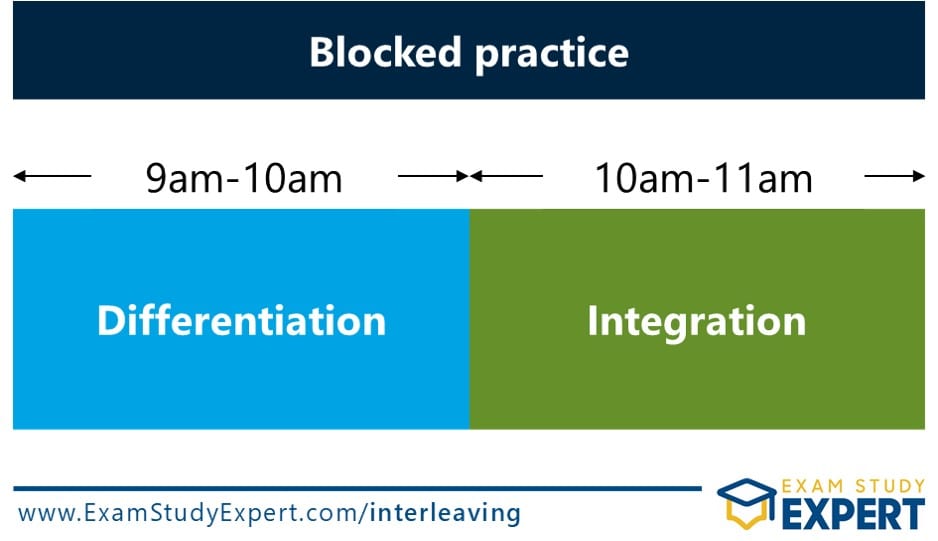
Blocked practice is everywhere in education.
Blocking is virtually the default approach wherever you look:
- It’s how textbooks set out their practice problems.
- Many homework assignments sheets are laid out like this.
- And it’s how most students organise the studying they do in preparation for tests and exams.
But it’s not necessarily the most effective approach.
Enter interleaving:
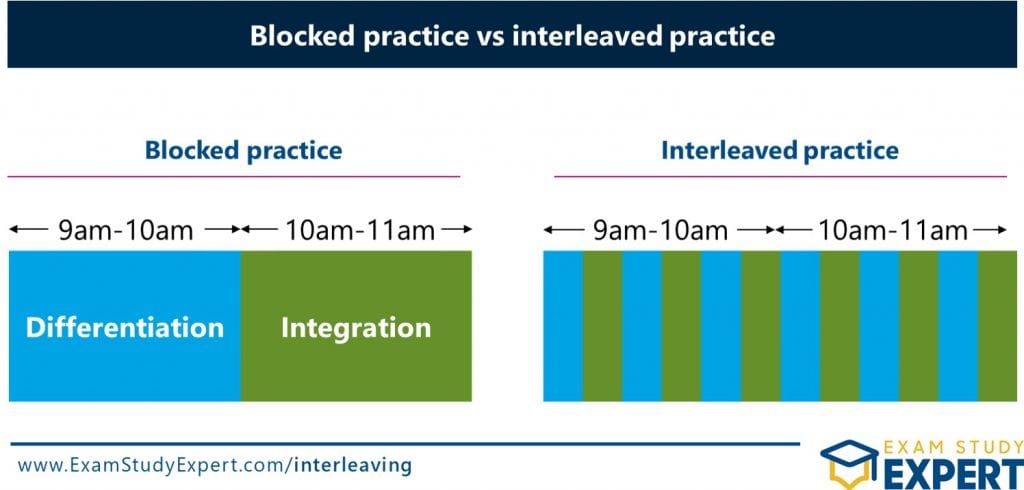
In this example, rather than spending an hour on differentiation and an hour on integration (blocking), you interleave by working on maybe 1 or 2 differentiation problems, then 1 or 2 integration problems, and so on, continually alternating between your integration and differentiation.
“In interleaving, you repeatedly switch back and forth between solving two (typically, related) types of problems, such that you never do more than a small number of problems of the same type in a row before switching to the other type of problem.”
Exam Study Expert definition
To use interleaving well, you’re aiming to introduce a certain amount of “desirable difficulty”: just like a physical workout, a mental workout (studying / learning) should be at least somewhat challenging to give you the maximum benefit in the shortest space of time.
How does interleaving work? Benefits of interleaved practice
There is good consensus among psychologists for the benefits of interleaved practice: see reviews by Pan, 2015 or Rohrer, 2012.
There are 3 main benefits of interleaving:
1. The “cold start” effect
In blocked practice, you only need to bring the correct methodology to mind once. After you’ve solved the first question, and especially once you’ve done a few, it becomes easy to do more. You no longer need to recall the method you need: it’s already in memory from the previous run of questions.
Sadly, most exams aren’t like that. They’ll continually have you switching to new types of problem, so you’ll need to be good at jumping straight into each type of problem “from cold” without having had a whole run of identical question types beforehand to warm up on.
Interleaving lets you practice lots of these “cold starts” each time you switch from problem type A to B – so you get to practice over and over again remembering how to solve each type of problem.
That’ll make the exam feel far easier as a result.
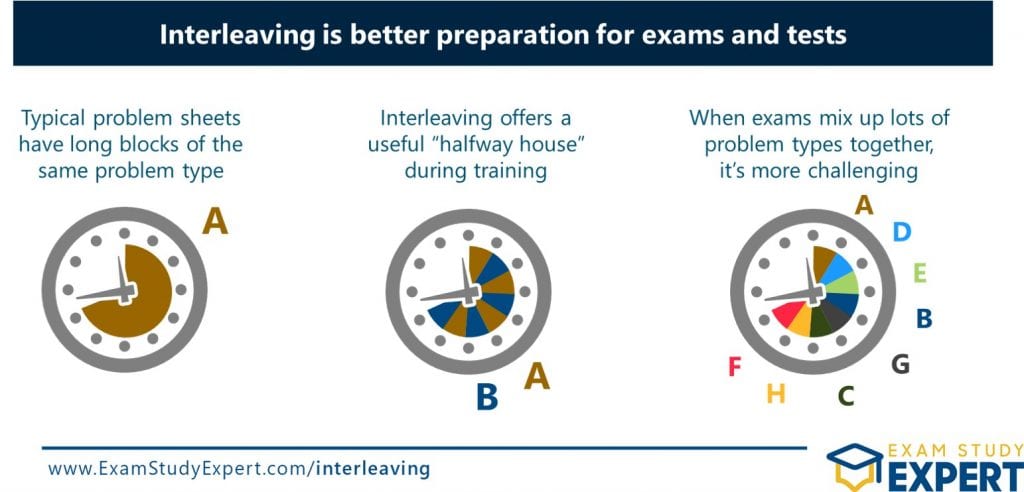
2. Spotting question types
The first battle in an exam can sometimes be simply recognising what type of question you’re faced with, and hence what method you need to bring to bear to solve it.
Interleaving helps you practice discerning between similar types of question, helping you recognise what’s being asked of you.
3. Avoiding confusion between similar methods
Finally, interleaved practice also helps you discern between similar methodologies.
Clearly, it’s not enough to stop at simply recognising whether it’s an integration or a differentiation question: you actually need to go ahead and solve it!
Interleaving helps with this too, because when you practice switching back and forth between two different methodologies that have the potential to cause confusion, you learn the crucial elements of each distinct methodology much faster and with a greater and more lasting confidence.
Integration and differentiation are great examples of this: at their most basic, these types of math(s) problems are solved in a distinct but often-confused way. By practising them together, you’re far less likely to get the two methodologies muddled in future.
What is the difference between interleaving practice and spacing learning?
Just a quick word on the difference between interleaving and spacing: they’re often confused! (see Chen, Paas & Sweller, 2021).
For me, the best way to summarise the difference is to say that:
Spaced learning is all about spreading learning out over time, separated by time lags.
Interleaving also has some elements of spreading learning out, but it’s less about the time lags, more about the juxtaposition of two related topics within a single learning session.
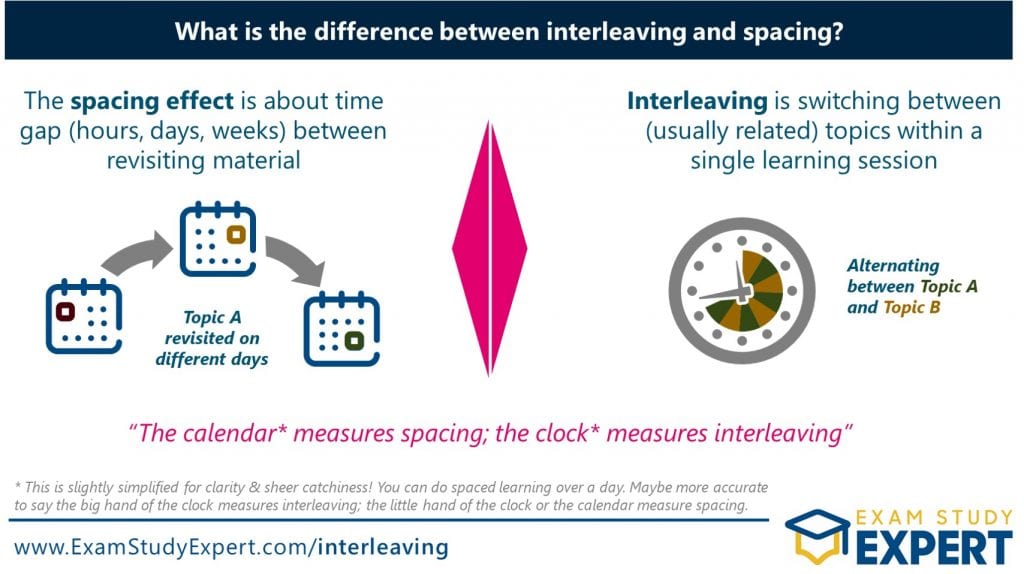
I sometimes say that the calendar measures spacing, while the clock measures interleaving, because the focus of interleaving is so squarely on swapping between two topics within a single learning session.
This is perhaps a little bit of an over-simplification, because it’s certainly possible to measure spacing on the clock, by leaving time lags of hours – so maybe slightly closer to the truth to say that the big hand of the clock measures interleaving, while spacing is measured by the little hand of the clock, or on the calendar.
What can be interleaved?
Interleaving doesn’t work for absolutely any type of learning – it tends to be best suited to practicing some kind of skill or procedure.
The classic example is problems in Math(s) or Science, but here’s my extended list of ideas of areas that have rich opportunity for interleaving:
- Math(s)
- Problems in Science, i.e. where you need to “do math(s)”
- Problems in Economics and Business Studies, i.e. where you need to “do math(s)”
- Grammar drills in languages: MFL (Modern Foreign Languages), Classics and English
- Physical skills: there’s great research (e.g. Kerr & Booth, 2013) on using interleaving to train physical skills in sport and P.E. – need to throw a ball into a bucket at 10 feet? Don’t do blocked practice at 10 feet, do interleaved practice at 8 feet and 12 feet, and you’ll get more accurate, faster. (I’m convinced this would apply to practising scales on musical instruments too!)
- Recognising and discerning: do you need to be able to tell your Picasso from Monet? Or to tell the difference between a Baroque and a Classical track? Interleaving is the perfect way to build mastery, faster.
For best effect, you’re ideally looking to interleave two similar problem types, where there’s potential for confusion.
So interleave integration and differentiation in Math(s), not integration and quadratic equations.
Or use interleaved practice to train skill in throwing a ball into a bucket at 10 feet vs 8 feet in physical education, not to train throwing a ball into a bucket at 10 feet vs doing the long jump.
Interleaving completely different things is not terribly helpful (Hausman & Kornell, 2014).
Interleaving studying: interleaved practice in learning
For students, the best way to think about interleaving is as like “high altitude training for the mind”.
Elite athletes make conditions slightly harder for themselves during training by running at high altitudes where the air is thin and their heart and lungs have to work harder. That makes it much easier to perform on race day.
So you should use interleaving in studying when you need to add in a little extra challenge to your practice – because by doing so, the big test or exam will feel way easier as a result (and you’ll score higher!).
Remember, you’re aiming to make your practice “just the right amount” of challenging, so if you’re really struggling with a topic, go back to blocking your practice, just doing the same type of problem repeatedly till the method starts to click.
If you’re still struggling with blocking, make it even easier still, and do “ultra-blocking”, where you just do the first step in the process for 10 problems in a row. Then solve the second step for all 10 problems. Then the third, and so on, until you’ve completed all necessary steps for all 10 problems.
But once you can, graduate from blocking, and get into interleaved practice.
If you’re studying for exams, “mix up” your practice by switching back and forth between a question or two on one type of problem, then a question or two on a different type.
It will feel more challenging: that’s the whole point!
Just like athletes training at high altitude, if you can find ways to studying harder, the exam will feel easier 😊
Interleaving teaching: interleaved practice in the classroom
This is often a source of confusion. Let’s start with what interleaved teaching shouldn’t look like.
I was speaking at a PD / inset day last September, and one of the questions afterwards was about whether the drama department was on the right lines with their interleaved curriculum, which I’ve summarised in the diagram below:
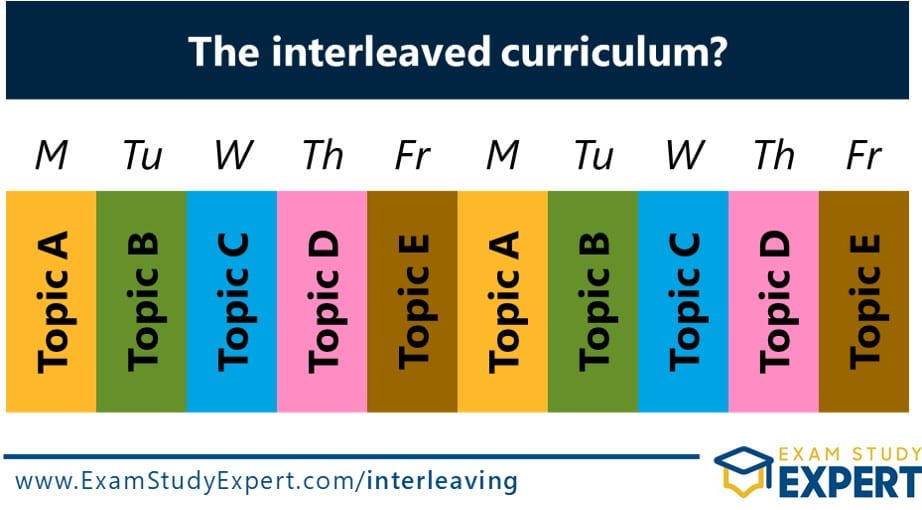
The interleaved curriculum? That way, madness lies…
Long story short: don’t do this.
You’ll go mad.
Your kids will go mad.
And nobody really benefits.
If you’re reading this article as a teacher and you have an interest in the science of learning, and especially if you’re UK-based, it’s possible you’ve come across Mark Enser’s concept of “interweaving”.
Interweaving boils down to bringing back little aspects or elements of previously taught topics as part of the current topic.
It’s a great concept, it’s got plenty of fans – and I’m one of them! I’d absolutely support Mark in promoting interweaving as a practical and effective tactic: you can read more about it here.
But strictly speaking, this is spaced practice, not interleaved practice.
So, what does true interleaving look like in teaching?
I see three main opportunities to put interleaving to work in the classroom:
1. Lesson planning: interleaving during instruction
Let’s say your chemistry class had got all muddled in a recent test on how to calculate their relative formula mass (Mr). So you schedule a few minutes at the start of tomorrow’s double lesson to re-teach the concept.
Perhaps it would be prudent to give them a question or two in the lesson to check they can do it.
But any questions you give immediately after the re-teaching will be artificially easy, because your clear explanation is ringing in short-term memory.
So if you really want to check the methodology has sunk in, you need to wait till they’ve “started to forget” your explanation.
You’ve got two options for that:
- Spacing: set the questions on a different day
- Interleaving: teach something else for a short time, before setting the Mr question(s)
Both are valid options, the interleaving practice option may be more practical.
2. Interleaving practice in homework assignments
Try to set homework assignments that use interleaving.
If the textbook questions are blocked (they normally are!), then give students a specific question order to work in to build in the interleaving: question 1, 11, 21, 31, then 2, 12, 22, 32, 3, 23, 33, 43.
Just be sure you’ve explained the benefits of interleaved practice (or linked them to this article!) or they’ll wonder what on Earth’s going on.
Remember, you’re aiming for optimum “desirable difficulty” – a bit challenging, but not completely impossible.
If this is the first time teaching a challenging problem type, you might want to start with blocking, to help students get their heads around what they’re supposed to be doing.
Then as confidence grows, gradually introduce interleaving to build challenge, and hence build mastery faster.
3. Interleaved practice as a differentiation strategy
Handling a large range of abilities in a single class can be a constant challenge.
Add interleaving as a tactic to your toolbelt when it comes to setting work that works for everybody in the room.
Everyone gets the same set of questions – whether as homework, or as an in-class assignment – but there are different paths through the same assignment.
- Students who struggle more do blocked practice: tackling questions 1-20 in order, which by way of illustration, might take them through questions 1-10 on Skill A before questions 11-20 on Skill B.
- Students who need more of a challenge do interleaving: tackling question 1, then 11, then 2, then 12, and so on – in effect, flipping back and forth between problems testing Skill A and Skill B.
Have fun with your interleaving, and please do share your feedback and further insights via the comments!
- [PODCAST] Peps McCrea: Hacking Study Motivation With Psychology - 27 Jan 2024
- Your Word Of The Year – Setting You Up For Success [PODCAST] - 2 Jan 2024
- Holiday Season Study Tips [PODCAST] - 21 Dec 2023



Hi,
I have inadvertently through trial and error incorporated many of the tips on your site. (I am older than dirt so I have had a lot of time to work on my method.)
One thing, I would add to your “system” would be a more varied form of switching up between topics.
I have found that doing other unrelated tasks, and activities also works and in some cases, works better. Things such as taking a walk, doing some other necessary task like taking out the trash, washing dishes. etc.
I have also, through mistake really, found that taking notes, putting the information in your own words also “super-charges” learning, especially with learning a language.
Best,
Mike